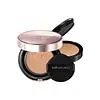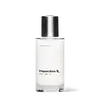What's inside
What's inside
 Key Ingredients
Key Ingredients

 Benefits
Benefits

 Concerns
Concerns

 Ingredients Side-by-side
Ingredients Side-by-side

Water
Skin ConditioningCI 77891
Cosmetic ColorantDimethicone
EmollientEthylhexyl Methoxycinnamate
UV AbsorberEthylhexyl Salicylate
UV AbsorberMethyl Trimethicone
Skin ConditioningGlycerin
HumectantButylene Glycol Dicaprylate/Dicaprate
EmollientDiphenylsiloxy Phenyl Trimethicone
Skin ConditioningLauryl PEG-10 Tris(Trimethylsiloxy)Silylethyl Dimethicone
EmulsifyingButylene Glycol
HumectantDiisostearyl Malate
EmollientNiacinamide
SmoothingPentylene Glycol
Skin ConditioningSynthetic Fluorphlogopite
Cyclopentasiloxane
EmollientCI 77492
Cosmetic ColorantCetyl Dimethicone
EmollientCetyl PEG/PPG-10/1 Dimethicone
EmulsifyingDiglycerin
Humectant1,2-Hexanediol
Skin ConditioningDisteardimonium Hectorite
StabilisingAcrylates/Stearyl Acrylate/Dimethicone Methacrylate Copolymer
Magnesium Sulfate
Phenoxyethanol
PreservativeDimethicone Crosspolymer
Emulsion StabilisingLauroyl Lysine
Skin ConditioningStearic Acid
CleansingCI 77491
Cosmetic ColorantAlumina
AbrasivePolyhydroxystearic Acid
EmulsifyingAluminum Hydroxide
EmollientTriethoxycaprylylsilane
CI 77499
Cosmetic ColorantIsododecane
EmollientOctyldodecanol
EmollientPolymethylsilsesquioxane
Propanediol
SolventPEG-9 Polydimethylsiloxyethyl Dimethicone
EmulsifyingParfum
MaskingEthylhexylglycerin
Skin ConditioningEthylhexyl Palmitate
EmollientIsopropyl Myristate
EmollientIsostearic Acid
CleansingLecithin
EmollientAdenosine
Skin ConditioningTrisodium Ethylenediamine Disuccinate
Polyglyceryl-3 Polyricinoleate
EmulsifyingOpuntia Ficus-Indica Fruit Extract
Skin ConditioningPolypropylsilsesquioxane
Polyglyceryl-4 Isostearate
EmulsifyingBenzyl Glycol
SolventIsopropyl Titanium Triisostearate
EmollientHydrolyzed Glycosaminoglycans
HumectantSodium Hyaluronate
HumectantCalcium Sodium Borosilicate
Trimethylsiloxysilicate
EmollientSodium Hyaluronate Crosspolymer
HumectantHydrolyzed Hyaluronic Acid
HumectantCholesteryl Chloride
Skin ConditioningCholesteryl Isostearate
EmollientCholesteryl Nonanoate
EmollientTocopherol
AntioxidantDiamond Powder
AbrasiveHydroxypropyltrimonium Hyaluronate
Hyaluronic Acid
HumectantBHT
AntioxidantSilica
AbrasiveSodium Acetylated Hyaluronate
HumectantWater, CI 77891, Dimethicone, Ethylhexyl Methoxycinnamate, Ethylhexyl Salicylate, Methyl Trimethicone, Glycerin, Butylene Glycol Dicaprylate/Dicaprate, Diphenylsiloxy Phenyl Trimethicone, Lauryl PEG-10 Tris(Trimethylsiloxy)Silylethyl Dimethicone, Butylene Glycol, Diisostearyl Malate, Niacinamide, Pentylene Glycol, Synthetic Fluorphlogopite, Cyclopentasiloxane, CI 77492, Cetyl Dimethicone, Cetyl PEG/PPG-10/1 Dimethicone, Diglycerin, 1,2-Hexanediol, Disteardimonium Hectorite, Acrylates/Stearyl Acrylate/Dimethicone Methacrylate Copolymer, Magnesium Sulfate, Phenoxyethanol, Dimethicone Crosspolymer, Lauroyl Lysine, Stearic Acid, CI 77491, Alumina, Polyhydroxystearic Acid, Aluminum Hydroxide, Triethoxycaprylylsilane, CI 77499, Isododecane, Octyldodecanol, Polymethylsilsesquioxane, Propanediol, PEG-9 Polydimethylsiloxyethyl Dimethicone, Parfum, Ethylhexylglycerin, Ethylhexyl Palmitate, Isopropyl Myristate, Isostearic Acid, Lecithin, Adenosine, Trisodium Ethylenediamine Disuccinate, Polyglyceryl-3 Polyricinoleate, Opuntia Ficus-Indica Fruit Extract, Polypropylsilsesquioxane, Polyglyceryl-4 Isostearate, Benzyl Glycol, Isopropyl Titanium Triisostearate, Hydrolyzed Glycosaminoglycans, Sodium Hyaluronate, Calcium Sodium Borosilicate, Trimethylsiloxysilicate, Sodium Hyaluronate Crosspolymer, Hydrolyzed Hyaluronic Acid, Cholesteryl Chloride, Cholesteryl Isostearate, Cholesteryl Nonanoate, Tocopherol, Diamond Powder, Hydroxypropyltrimonium Hyaluronate, Hyaluronic Acid, BHT, Silica, Sodium Acetylated Hyaluronate
Water
Skin ConditioningPanthenol
Skin ConditioningSqualane
EmollientGlycerin
HumectantPropanediol
SolventSucrose Distearate
EmollientCarthamus Tinctorius Seed Oil
MaskingLactococcus Ferment Lysate
Skin ConditioningGlucosyl Hesperidin
HumectantCarnosine
Skin ConditioningPhytosphingosine
Skin ConditioningCeramide NP
Skin ConditioningCeramide Ns
Skin ConditioningCeramide As
Skin ConditioningCeramide AP
Skin ConditioningCeramide EOP
Skin ConditioningCholesterol
EmollientPentylene Glycol
Skin ConditioningCetearyl Alcohol
EmollientStearic Acid
CleansingPolyquaternium-51
Skin ConditioningHydroxypropyl Methylcellulose
Emulsion StabilisingSodium Chloride
MaskingLithothamnion Calcareum Extract
Skin ConditioningAmylopectin
Sodium Hyaluronate
HumectantArginine
MaskingDextrin
AbsorbentXanthan Gum
EmulsifyingAcrylates/C10-30 Alkyl Acrylate Crosspolymer
Emulsion StabilisingAllantoin
Skin ConditioningDipotassium Glycyrrhizate
HumectantCI 77220
Cosmetic ColorantCitric Acid
BufferingHydrogenated Lecithin
EmulsifyingPotassium Cetyl Phosphate
Emulsifying1,2-Hexanediol
Skin ConditioningHydroxyacetophenone
AntioxidantPotassium Sorbate
PreservativePotassium Benzoate
PreservativePhenylpropanol
MaskingLevulinic Acid
PerfumingSodium Levulinate
Skin ConditioningWater, Panthenol, Squalane, Glycerin, Propanediol, Sucrose Distearate, Carthamus Tinctorius Seed Oil, Lactococcus Ferment Lysate, Glucosyl Hesperidin, Carnosine, Phytosphingosine, Ceramide NP, Ceramide Ns, Ceramide As, Ceramide AP, Ceramide EOP, Cholesterol, Pentylene Glycol, Cetearyl Alcohol, Stearic Acid, Polyquaternium-51, Hydroxypropyl Methylcellulose, Sodium Chloride, Lithothamnion Calcareum Extract, Amylopectin, Sodium Hyaluronate, Arginine, Dextrin, Xanthan Gum, Acrylates/C10-30 Alkyl Acrylate Crosspolymer, Allantoin, Dipotassium Glycyrrhizate, CI 77220, Citric Acid, Hydrogenated Lecithin, Potassium Cetyl Phosphate, 1,2-Hexanediol, Hydroxyacetophenone, Potassium Sorbate, Potassium Benzoate, Phenylpropanol, Levulinic Acid, Sodium Levulinate
 Reviews
Reviews

Ingredients Explained
These ingredients are found in both products.
Ingredients higher up in an ingredient list are typically present in a larger amount.
1,2-Hexanediol is a synthetic liquid and another multi-functional powerhouse.
It is a:
- Humectant, drawing moisture into the skin
- Emollient, helping to soften skin
- Solvent, dispersing and stabilizing formulas
- Preservative booster, enhancing the antimicrobial activity of other preservatives
Glycerin is already naturally found in your skin. It helps moisturize and protect your skin.
A study from 2016 found glycerin to be more effective as a humectant than AHAs and hyaluronic acid.
As a humectant, it helps the skin stay hydrated by pulling moisture to your skin. The low molecular weight of glycerin allows it to pull moisture into the deeper layers of your skin.
Hydrated skin improves your skin barrier; Your skin barrier helps protect against irritants and bacteria.
Glycerin has also been found to have antimicrobial and antiviral properties. Due to these properties, glycerin is often used in wound and burn treatments.
In cosmetics, glycerin is usually derived from plants such as soybean or palm. However, it can also be sourced from animals, such as tallow or animal fat.
This ingredient is organic, colorless, odorless, and non-toxic.
Glycerin is the name for this ingredient in American English. British English uses Glycerol/Glycerine.
Learn more about GlycerinPentylene glycol is typically used within a product to thicken it. It also adds a smooth, soft, and moisturizing feel to the product. It is naturally found in plants such as sugar beets.
The hydrophilic trait of Pentylene Glycol makes it a humectant. As a humectant, Pentylene Glycol helps draw moisture from the air to your skin. This can help keep your skin hydrated.
This property also makes Pentylene Glycol a great texture enhancer. It can also help thicken or stabilize a product.
Pentylene Glycol also acts as a mild preservative and helps to keep a product microbe-free.
Some people may experience mild eye and skin irritation from Pentylene Glycol. We always recommend speaking with a professional about using this ingredient in your routine.
Pentylene Glycol has a low molecular weight and is part of the 1,2-glycol family.
Learn more about Pentylene GlycolPropanediol is an all-star ingredient. It softens, hydrates, and smooths the skin.
It’s often used to:
Propanediol is not likely to cause sensitivity and considered safe to use. It is derived from corn or petroleum with a clear color and no scent.
Learn more about PropanediolSodium Hyaluronate is hyaluronic acid's salt form. It is commonly derived from the sodium salt of hyaluronic acid.
Like hyaluronic acid, it is great at holding water and acts as a humectant. This makes it a great skin hydrating ingredient.
Sodium Hyaluronate is naturally occurring in our bodies and is mostly found in eye fluid and joints.
These are some other common types of Hyaluronic Acid:
Learn more about Sodium HyaluronateStearic Acid is a fatty acid. It is an emollient, emulsifier, and texture enhancer.
As an emollient, stearic acid helps soften skin. It aids the skin's protective barrier by preventing water loss. It also provides a gentle cleansing effect without stripping away natural oils.
Stearic acid may also be used to enhance the texture of products. It can add volume and stabilize ingredients such as water and oil. This can help water and oil ingredients from separating.
Sources of stearic acid include animal or vegetable fats/oils such as coconut or shea. It can be naturally found in butter, cocoa butter, shea butter, vegetable fats, and animal tallow.
This ingredient may not be Malassezia folliculitis, or fungal-acne safe.
Learn more about Stearic AcidWater. It's the most common cosmetic ingredient of all. You'll usually see it at the top of ingredient lists, meaning that it makes up the largest part of the product.
So why is it so popular? Water most often acts as a solvent - this means that it helps dissolve other ingredients into the formulation.
You'll also recognize water as that liquid we all need to stay alive. If you see this, drink a glass of water. Stay hydrated!
Learn more about Water